Castlemilk
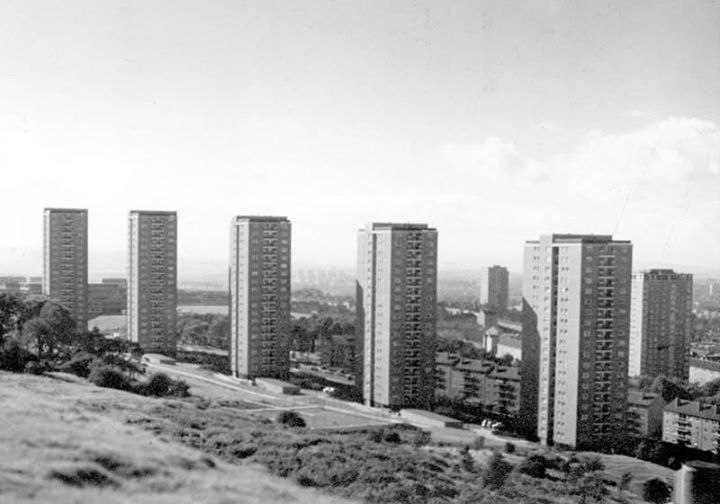 Source: Mitchell Hill Flats, September 1970, Castlemilk History facebook page
Source: Mitchell Hill Flats, September 1970, Castlemilk History facebook page
To find out more about what it was like to live in a high rise flat in Castlemilk follow the following links to read responses to our online questionnaire or listen to extracts from oral histories conducted for the project:
Online Questionnaire Responses
Online Oral History Resource
A brief history of Castlemilk housing estate
Castlemilk is one of the four post-war ‘Peripheral’ housing estates constructed in Glasgow (the others being Drumchapel, Easterhouse and Pollock). The idea of building a housing estate on the land occupied by Castlemilk House and Estate was conceived of in the interwar years. The land was acquired by Compulsory Purchase Order (CPO) in 1936.
The owner of Castlemilk house and its lands, William Crawfurd Stirling Stuart, 83 years old at the time of the legal dispute over the Compulsory Purchase Order of his property in 1936, had concerns about the use of his land for working-class housing. He had already sold a portion of his land to a private house builder, Mathew Dickie, who had previously built bungalows in neighbouring Croftfoot and Burnside. In their objections to the CPO Stirling and Dickie suggested that the land was too far away from the ‘industrial areas’ and therefore was too remote for working classes.
Planning of the new housing scheme did not begin until the 1940s. Originally 6,250 houses had been envisaged, but by 1941 in the plans it had become the largest municipal housing scheme the Corporation was to construct, covering an area of two and a half square miles. Drawings and models were ready by 1944, the layout was approved in 1952 and work began in 1953. At that point the Corporation planned to build 8,300 houses at a cost of £16m (approx £402m today).
For more on the early days of Castlemilk see Castlemilk People’s History Group, The Big Flit, 1990 and for history of the area more generally see Castlemilk History Group, An Incomplete History of Castlemilk, 1993. (Both groups were funded by the WEA (Workers Education Association)). The Castlemilk History facebook page is an indispensible source of information on the history of Castlemilk. Where indicated, the images on this page have been reproduced with permission from Castlemilk History.
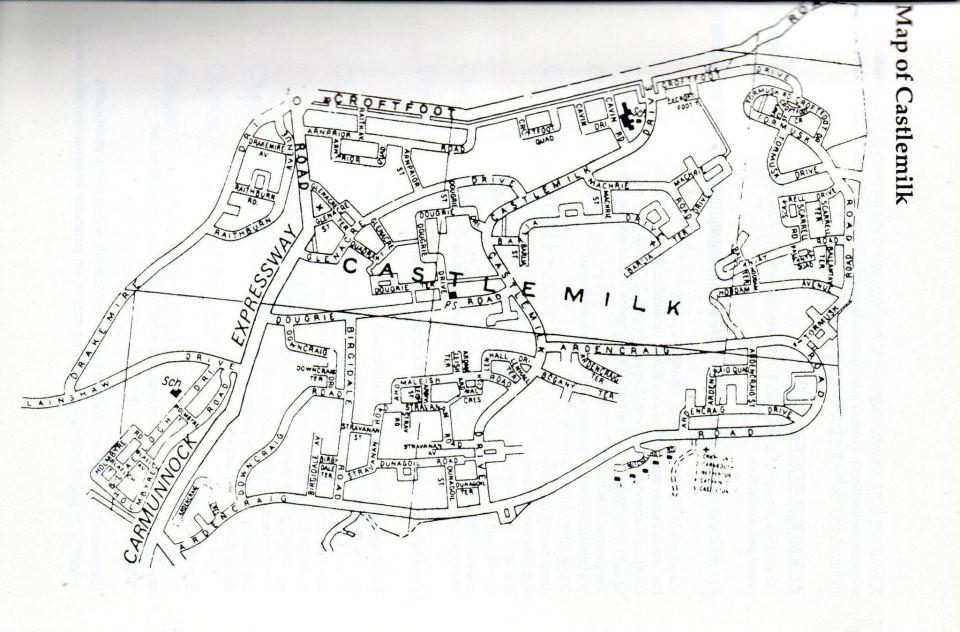
Source: Planned Layout of Castlemilk, 1952, Castlemilk History facebook page
Much of the housing was planned as tenements four storeys high and was monotonous in design. It is difficult to say whether ‘modernist’ architecture was influential in the building of Castlemilk. A third of the houses in Castlemilk were built to the same design, a ‘T’ design, with a verandah at the front of the houses. A similar design was used in Drumchapel and Easterhouse. Perhaps the introduction of the verandah was a ‘modern’ feature inspired by building on the continent and developments in architecture. But the ‘modern’ aesthetic is not generally a description associated with Castlemilk.
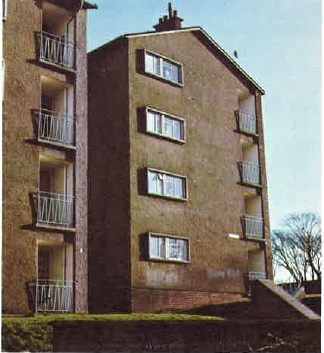
Source: Glasgow Corporation, Farewell to the Single End, 1975
Castlemilk, and the other peripheral estates, had been envisaged as independent ‘townships’ where people would both live and work. However infamously the tenants were not provided with amenities for social life and very little employment was available. Perhaps the Corporation was full of good intentions but never had the funds to ensure that the ‘townships’ became fully functioning and independent.
The Corporation’s failure to offset the physical isolation of Castlemilk had adverse effects in the long term. There were only a few shops until the shopping centre was completed in 1963, the first health centre was in the 1980s, there was no job centre even when unemployment increased in the 1970s, there was no DHS or housing office until the 1970s. In addition there were no leisure facilities such as a sports centre until the 1980s, there was one pub and no cinemas. The Catholic chapel and Protestant churches were very well attended in the 1950s as they provided much of the social services and activities in the area.
Public transport facilities in Castlemilk have been criticised since the scheme was first built. Many people had to travel back into the city centre for work. Some men travelled all the way from Castlemilk to the ship yards in Govan, two bus rides away, which is a substantial commute. It was also a long way for women to travel into the city for the shops or work, with an inadequate expensive bus service and no trains.
High rise flats in Castlemilk
Given the problems that Castlemilk was already facing by the early 1960s, in terms of the scheme’s isolation and lack of amenities, it is interesting that the Corporation decided to build high rise multi-storey flats in three locations. Although, given the scale of Glasgow Corporation’s high rise housing drive and the policy of building on gap sites, perhaps it was not that surprising.
The first approved in 1960 were three twenty-storey blocks in Dougrie Place which were built in the middle of the estate near the recently constructed shopping centre.

Source: Dougrie Flats (late 1970s), Castlemilk History facebook page © Jim Richardson
The Mitchellhill flats, which consisted of five twenty-storey blocks on the southern most edge of the estate on Ardencraig Road, were approved in 1963 and completed only two years later by Wimpey in 1965.
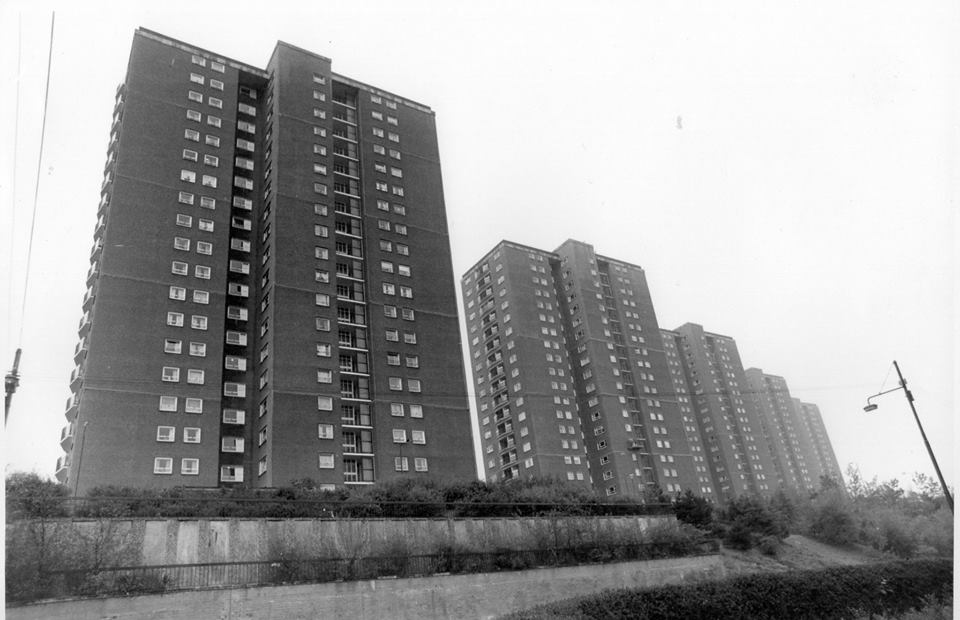
Source: Mitchellhill flats (late 1970s), Castlemilk History facebook page © Jim Richardson
'one of the most driving motives for building high blocks, even in Glasgow, was prestige. That's why Glasgow Corporation, for instance, got us to build that tremendously prominent line of tower blocks at Ardencraig Road, on the skyline above Castlemilk [in 1963-65]. It would have been far more practical to build those high blocks in a hollow rather than on a hill, and I said to Cross 'You're mad building them up there - we'll have to blast huge amounts of rock!' To get round that, we were allowed by DHS to turn the blocks off their daylighting axis: they told us to get on with it and not tell anyone!'
(M. Glendinning interview with Tom Smyth, former principle architect, Scottish Division, Wimpey Ltd, 5 July 1987, see M. Glendinning and Diane Watters, Homebuilders, Mactaggart and Mickel and the Scottish housebuilding industry, (Edinburgh: RCHAMS, 1999), p. 290 )
Jephcott made Mitchellhill one of her study areas due to its semi-rural location. It was built at the furthest, southern edge of the scheme. The shops and schools were at least a twenty minute walk. The site therefore was exposed to the worst of the Scottish winter. Moreover the flats had a high proportion of young children. ‘The Jeely Piece Song’ by Adam McNaughton [lyrics], which Jephcott quotes in an appendix at the end of Homes in High Flats, was written about Mitchellhill.
The final addition was a twenty-storey block at Bogany terrace to the south-east of the state, which was approved in 1966 and also constructed by Wimpey
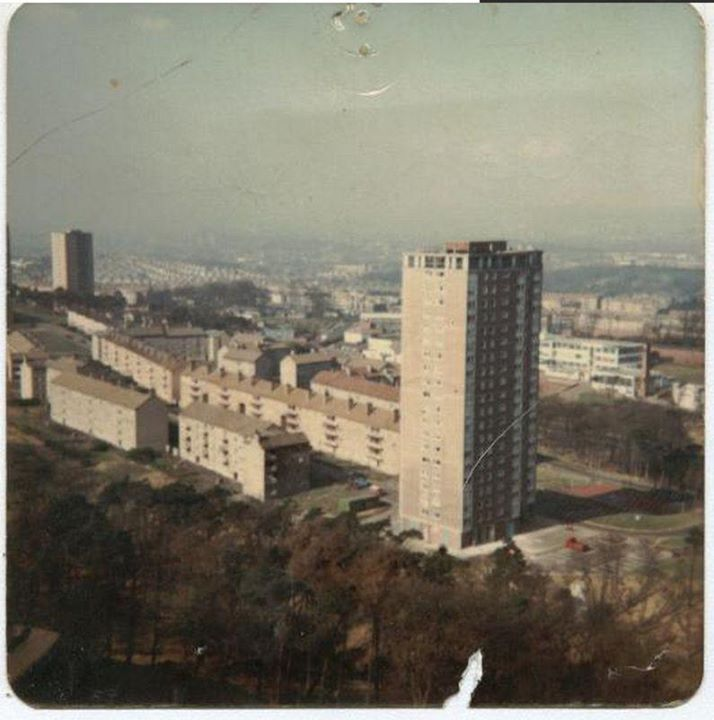 Source: Bogany flats, Castlemilk History facebook page
Source: Bogany flats, Castlemilk History facebook page
The package deals offered by private building companies enabled the Corporation to build very quickly and subsidies helped them build cheaply (or so they thought at the time, not taking into account the later cost of maintenance).
The Dougrie flats were perhaps the most ‘successful’ as they are still standing today. In contrast Bogany, last to be built, was the first to be demolished in 1993. Mitchellhill was demolished in 2005, even though the council had recently spent £1.5m upgrading the blocks.

This work is licensed under a Creative Commons Attribution-NonCommercial-ShareAlike 4.0 International License.
Some material on this website is not being made available under the terms of this licence.
These are:
Third-Party materials that is being used under fair use or with permission (photography owned by archives, blog contributors or from WikiMedia Commons). The respective copyright/Creative Commons licence details for use of third-party material should be consulted.

